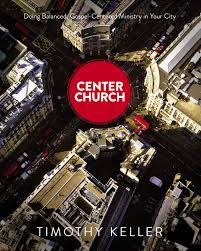This review originally appeared at InfluenceMagazine.com.
Timothy Keller, Center Church: Doing Balanced, Gospel-Centered Ministry in Your City (Grand Rapids, MI: Zondervan, 2012). Hardcover | Kindle
Although the majority of Americans continues to self-identify as Christian, American culture is increasingly post-Christian. Evangelical Christians could once assume the broader culture agreed with them about the existence of God, the shape of moral living, and the usefulness of religious organizations. They can no longer do so. The urgent question evangelicals need to ask and answer is how to minister the gospel in this new cultural environment.
Timothy Keller outlines an answer to that question in Center Church. Keller is founder and pastor of Redeemer Presbyterian Church in New York City, and a New York Times bestselling author. Through Redeemer City to City, he mentors young urban church planters and pastors. Keller is also cofounder of The Gospel Coalition, a movement associated with the New Calvinism and the resurgence of a complementarian understanding of gender roles. As a Pentecostal, I disagree with both his Calvinism and complementarianism, though I hasten to add he doesn’t make them points of contentions in his book. Regardless, I believe that Center Church offers a theological vision of gospel ministry that repays careful consideration by ministers across the evangelical spectrum.
Books about church tend to fall into two categories: what to believe (doctrine) and what to do (ministry). Center Church brings the two together in fruitful dialogue, resulting in “theological vision.” Keller writes: “a theological vision is a vision for what you are going to do with your doctrine in a particular time and place.” It develops “from deep reflection on the Bible itself, but it also depends a great deal on what you think of the culture around you.”
Keller organizes his theological vision for ministry around three commitments: gospel, city, and movement. “Both the Bible and church history show us that it is possible to hold all the correct individual biblical doctrines and yet functionally lose our grasp on the gospel,” he writes. “It is critical, therefore, in every new generation and setting to find ways to communicate the gospel clearly and strikingly, distinguishing it from its opposites and counterfeits” (emphasis in original). Keller takes up this task in Parts 1 and 2, which focus on “Gospel Theology” and “Gospel Renewal” (or “Revival”), respectively.
Parts 3, 4, and 5 focus on “Gospel Contextualization,” “City Vision,” and “Cultural Engagement,” respectively. Keller writes: “All churches must understand, love, and identify with their local community and social setting, and yet at the same time be able and willing to critique and challenge it.” These chapters are, in my opinion, the best in a very good book. We often think of missiology as the study of missions internationally—across national, cultural, and linguistic boundaries. What Keller demonstrates is that missiological thinking is relevant intranationally—within our own culture. Evangelicals should not assume, as we have done for so long, that America is a Christian nation. We should rather approach it as a mission field and think of ourselves as missionaries to it.
Finally, Parts 6, 7, and 8 focus on “Missional Community,” “Integrative Ministry,” and “Movement Dynamics,” respectively. This last topic “has to do with your church’s relationships” (emphasis in original). “Some churches are highly institutional,” Keller writes, “with a strong emphasis on their own past, while others are anti-institutional, fluid, and marked by constant innovation and change.” Keller advocates a balanced position between tradition and innovation, drawing on the best of both.
Indeed, balanced is a useful way to describe Keller’s theological vision throughout the book. Keller speaks of “the balance of three axes.” On the gospel axis, the Church must balance between legalism and antinomianism. “We are saved by faith and grace alone, but not by a faith that remains alone,” he writes. “True grace always results in changed lives of holiness and justice.” On the city axis, the Church must balance between only challenging the culture and only appreciating it. “This is based on the biblical teaching that all cultures have God’s grace and natural revelation in them, yet they are also in rebellious idolatry.” On the movement axis, the Church must balance between being an organization (focused on tradition and authority) and an organism (focused on cooperation and unity). “[A] church at either extreme will stifle the development of leadership and strangle the health of the church as a corporate body, as a community,” Keller writes. “The more that ministry comes ‘from the center’ of all the axes, the more dynamism and fruitfulness it will have.”
Center Church is not a quick read. It is a 400-page, two-columned textbook. If you’re looking for easy answers or quick fixes, this is not the book to read. On the other hand, if you’re willing to put in the time and effort, reading this book will change the way you think about gospel ministry in a post-Christian era.
—–
P.S. If you found my review helpful, please vote “Yes” on my Amazon.com review page.


